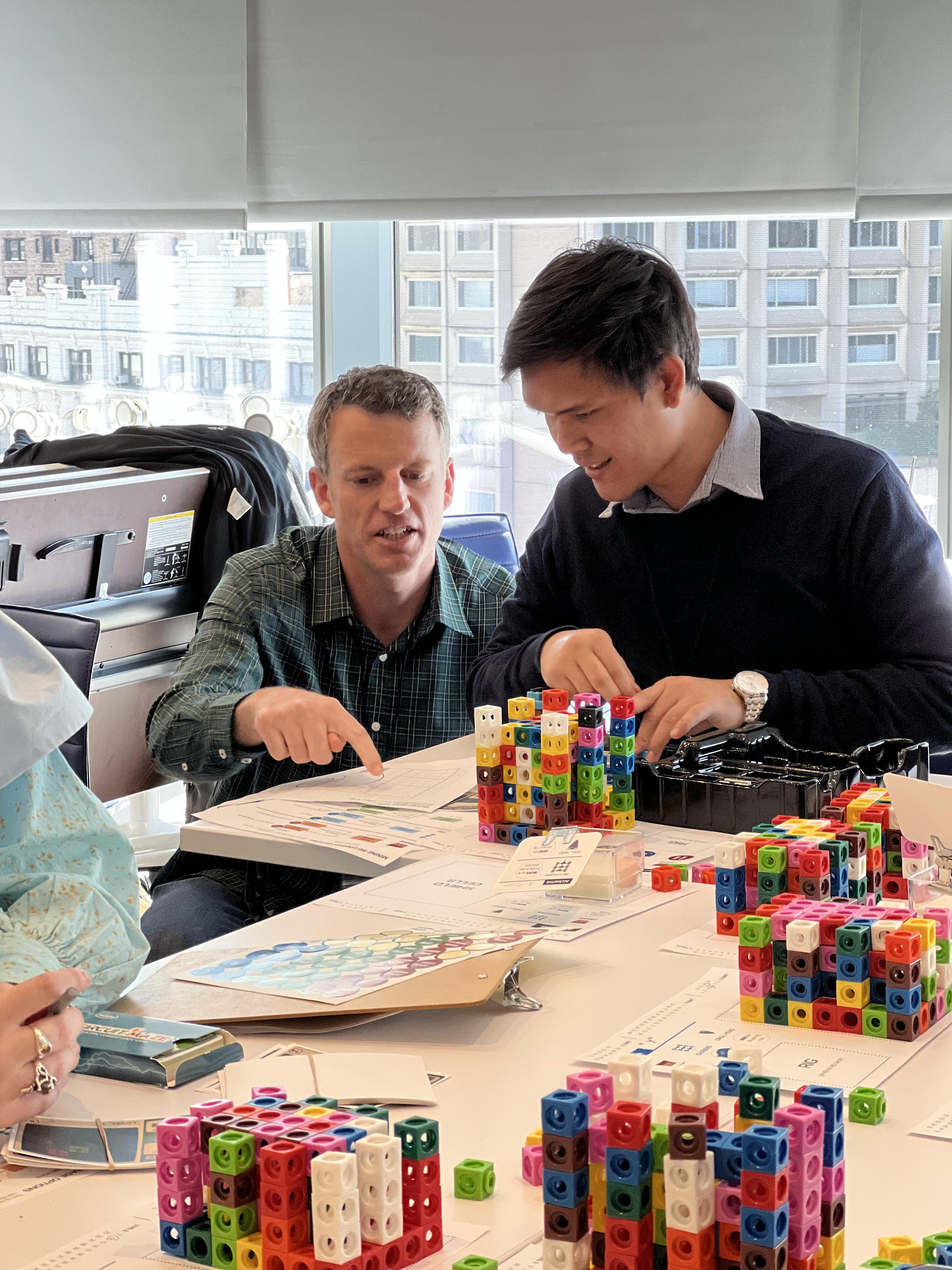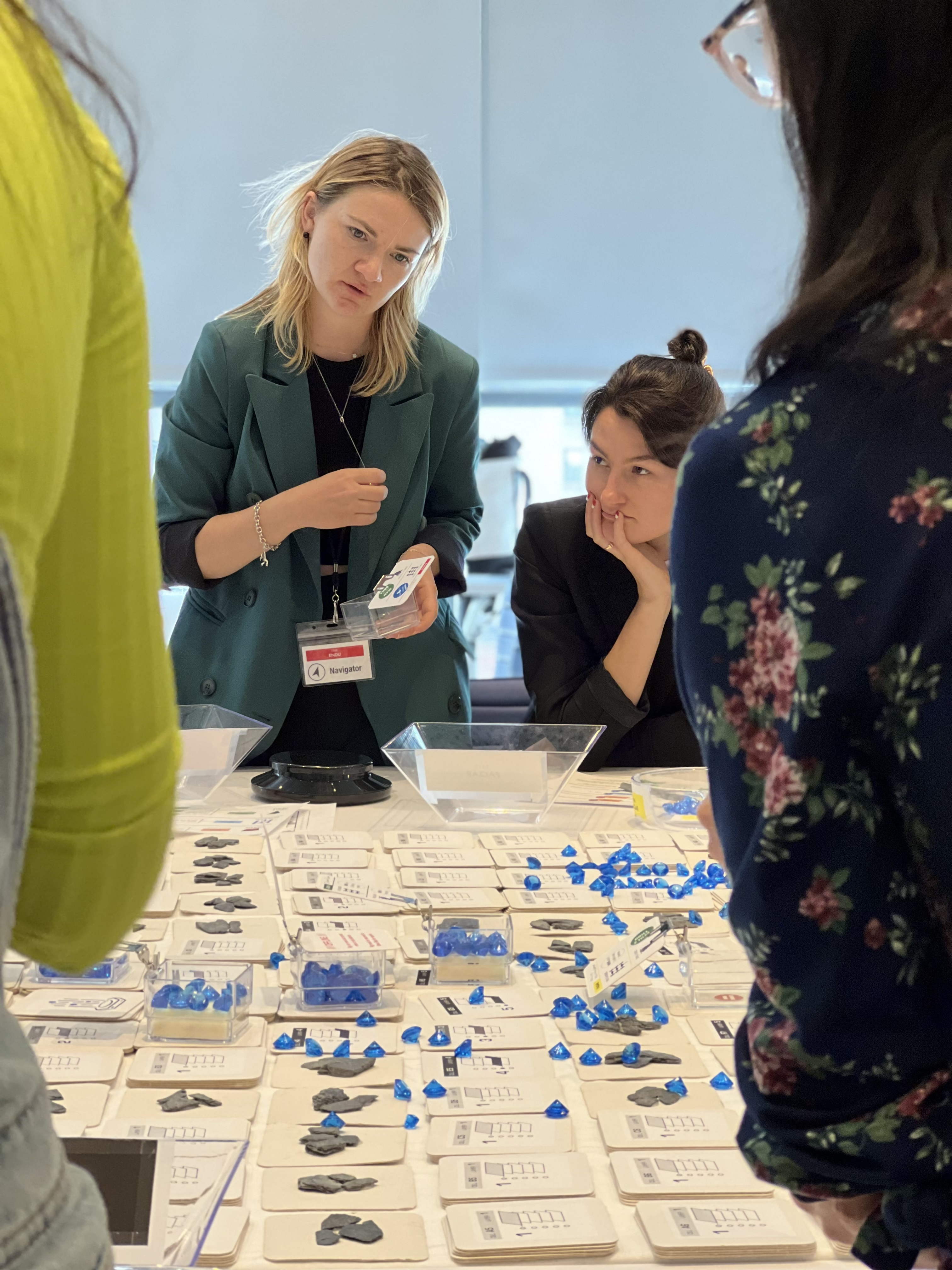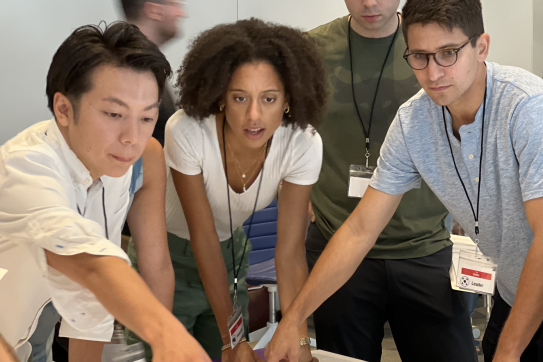Racing the clock between solar storms and seismic events, a team of space miners hunts for “allocite” on a deep-space asteroid in a do-or-die attempt to save their colony. The team’s leader scrambles to guide their crew through the chaos. Their engineer toils to repair a badly damaged drill head. The navigator looks for input from the team’s analyst on mining strategy. Unable to find him, she makes a tough call on her own, sending a mining rig careening across the asteroid, and into potential harm, in search of the lifesaving materials they need.
As the action reaches a fever pitch, a gong sounds, abruptly signaling the end of the mining sprint. A half-dozen teams return to base camp—a Columbia Business School classroom in Manhattanville. There, the lead choreographer of the simulation, Daniel Ames, the Ting Tsung and Wei Fong Chao Professor of Business, points out QR codes that link to feedback surveys. The room falls silent as students pull out their phones and tablets to reflect on their own experiences and evaluate how their fellow team members are performing in Lucidian, the “space mining” game Ames created for his Immersive Teamwork course. “Lucidian presents students with an intense, multi-hour hands-on teamwork stress test,” says Ames. “We hit the pause button mid-mission for people to capture their thoughts in digital diaries. Then, after a few minutes, we flip the switch and they’re back in space for another hour and a half of mayhem.”

Todd Carlson ’22, left, and Seltadino Abadi ’22 working together in an impromptu team
Before launching the course, Ames worked on Lucidian for four years, collaborating with immersive theater expert Dalton Gray and game designer Caroline Porter, refining the activity through tests with dozens of teams. “No other business school has a teamwork course like this, mixing deep-dive operational simulations, creative design projects, and tech-enabled peer feedback,” says Ames. The outer space activity pushes students to test their abilities as cross-functional team members or leaders. Without enough time to fully explain their roles to each other, players operate with incomplete information—and leaders juggle to keep everyone synchronized. Ames also bakes in some surprises, giving teams opportunities to support or betray one another, leading to cries of joy and groans of pain.
Not All Fun and Games
Typically, games are fun, but like Mario Kart, the No. 1 stress-inducing video game according to Forbes, Lucidian activates a level of tension. “It’s not meant to be fun,” says Ames of Lucidian. “The whole experience is designed to propel personal development. We ask students to push themselves out of their comfort zones. Then we hold up a mirror for them to reflect on themselves and their teams.” Self-reflection can be revealing. “I learned that pressure makes it hard for me to think, and I like to be prepared,” says MBA second-year student Cole Ahnell ’23. “I learned that in chaos, taking too much time to think can paralyze a team.”
The reflections and critiques students give one another throughout the two-and-a-half- day course help them glean important lessons to apply to future teamwork situations. Ames wants his students to closely observe how they express themselves and communicate in teams, how they react to stress, and how they generate ideas, in whatever role each may play. To that end, Ames urges students to choose the space-mining role that is least comfortable for them. If someone naturally gravitates toward leadership roles, he councils them to be an analyst or engineer. In many cases, extroverts take the supporting roles while introverts step into leadership positions, says Ames. What can be learned by going against type? A lot.
MBA second-year student John Scalamandre ’23, chose to be a navigator. “I generally prefer to have a thorough analysis prior to making a decision and would rather not be forced to make quick decisions with little information,” says Scalamandre, who didn’t have that luxury in Lucidian. As navigator, he learned that he needed improvement in a critical teamwork capability: communicating. While the game helped him see strengths in his adaptability and leadership readiness, he says it “also gave me some points to work on, mainly communication within my team in situations where I would rather push forward and get it done.”
“The most impactful lesson learned for me is trust the process. I had to quickly adapt to relying on the journey and my teammates. I had to learn to place faith in our ideas and believe in our product, even though I couldn’t see the end result.”
- Tami Thompson ’23 , MBA student and US Navy officer
At the Core of Team Functions
The course revolves around Ames’s “Team Functions” framework, which stresses the importance of two core processes: communication (how team members express themselves and understand each other) and conflict (how team members address differences), built on a foundation of climate (how members view one another and the team). During the course’s second day, groups are reshuffled to tackle a creative challenge: design a game revolving around team dynamics such as coordination. It’s a different kind of pressure but one the students feel acutely, knowing their classmates will play their game the next morning. While communication was an issue in Scalamandre’s Lucidian experience, trust was the main focus in the game design exercise for second-year MBA student and US Navy officer Tami Thompson ’23.

Alena Shurtakova ’23, left, and Grace Zimmerman ’24 playing a new game
“The design challenge was a bit of a whirlwind for me because I couldn’t see the forest through the trees,” says Thompson. “Usually, I know where I want to end up but have to figure out how to get there. In creating the team game, we were given a general direction but had no clue where we were going, and that was a bit scary.” She adds, “The most impactful lesson learned for me is trust the process. I had to quickly adapt to relying on the journey and my teammates. I had to learn to place faith in our ideas and believe in our product, even though I couldn’t see the end result.” Insights and lessons were plentiful during the course.
Ahnell, who says he learned from the self-reflections, also found Immersive Teamwork challenging and relatable to work situations. “In business, you’re not only tackling the problems you deal with for your company, but you are also managing emotions, expectations, and desires of other human beings,” he says, referring to team dynamics. “Honestly, it was one of the best and most-exhausting courses I have taken during my time at CBS.”
